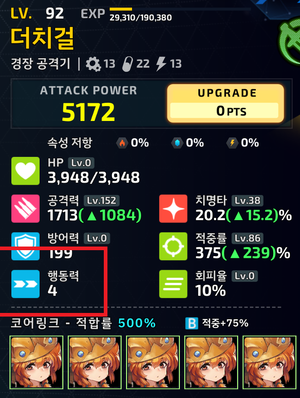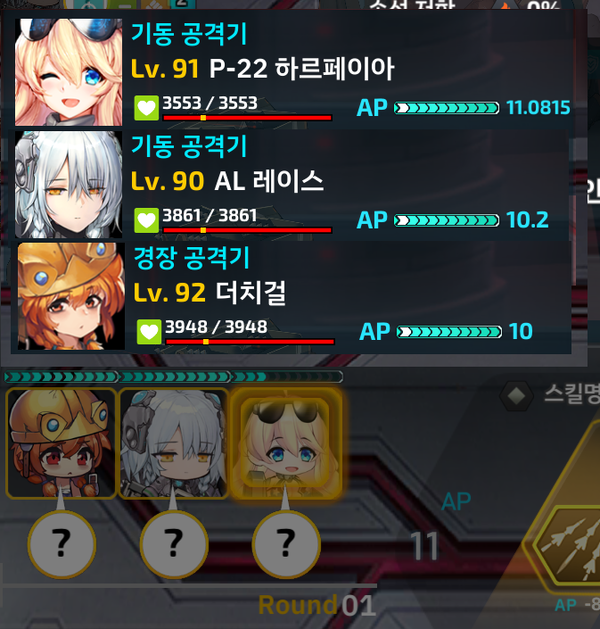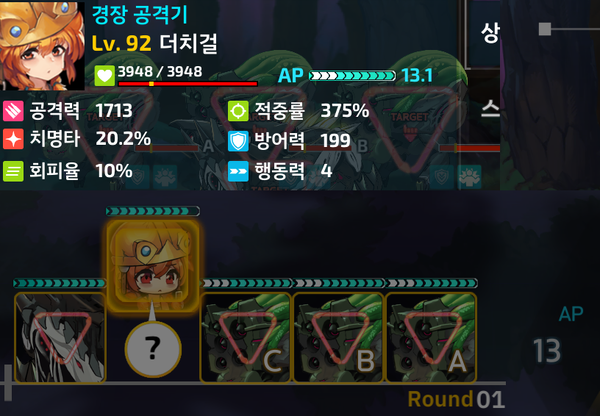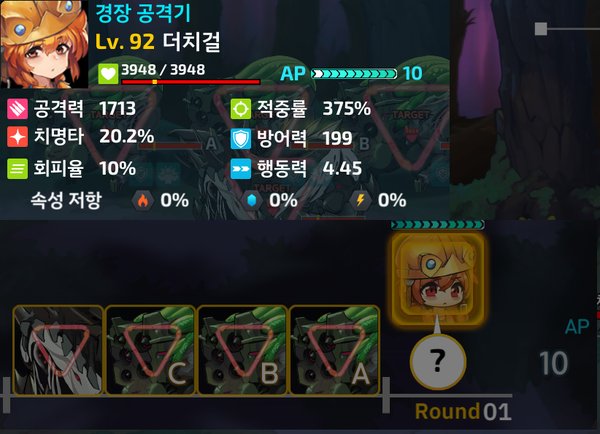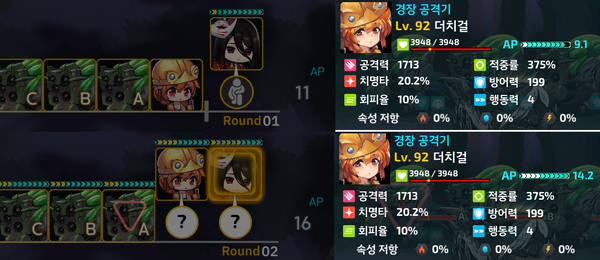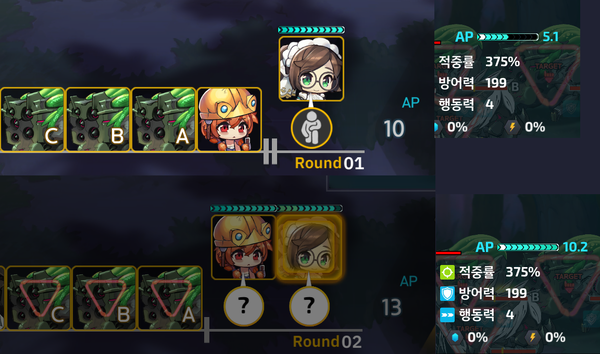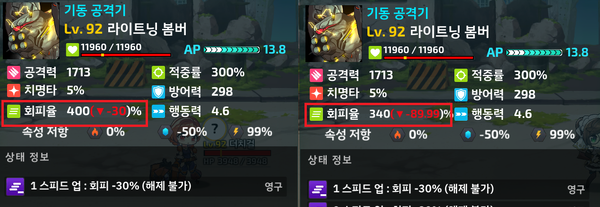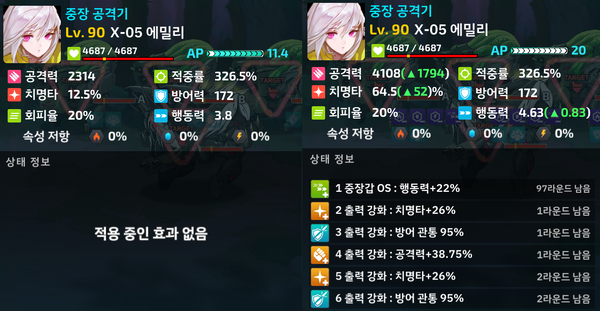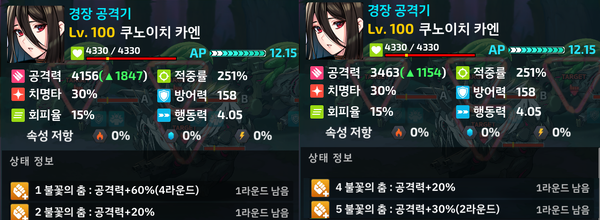Speed and AP
The Basics
Have you ever noticed this number right here? That's speed. It decides how much AP you get between rounds.
AP stands for action point. It decides who moves in that round. It also decide the order of turn taking in that round. While it is easy to conflate AP and SPD, it is important to distinguish them.
At the start of a round, if you have 10 AP or more, you can take an action. If you don't have 10 AP, you can't take action. You used an attack but you still have more than 10 AP? You get to attack again for that round.
The first round starts with Dutch Girl at 10 AP. Since she has 10 AP, she gets to move. Tyrant doesn't have 10 AP, so he doesn't get to move.
All actions cost AP, including physically moving your character to another tile (2 AP) and idling (1 AP). By idling, you basically save up most of your AP in your current round in order to have more of them in the next round. So you can potentially move first and even move twice. Speaking of moving first, the order in which units take action in a round depends on their AP.
The one with the most AP moves first and the one with 10 AP moves last since that's the bare minimum.
Notice the amount of AP each units have and how it correlates to the order of which they will move.
You can have up to 20 AP max, any more than that will be removed. But having 20 AP means units that use 10 AP (which is the cap for AP cost) for both actives like Emily can attack twice in that round. You can only use your actives twice per round even though you still have enough AP for another attack.
So to recap on SPD and AP:
- SPD = AP per round.
- 10 AP = you move.
- You have more AP? You move first.
- Still have 10 AP after 1 attack? Attack again.
- 20 AP max.
- 2 actives max per round.
Buffs and Debuffs
AP buffs/debuffs
These kinds of buffs and debuffs work by adding/reducing AP directly to the affected units. These changes immediately affect the turn taking of units in a single round and can even prevent units from taking their turn in that round if their AP is reduced below 10.
These buffs can be applied in many ways:
- AP at the start of the wave (Start AP). EX: Dark Elven Forest Ranger. These AP buffs are applied immediately at the start of the wave and are always factored into deciding the first round.
- AP at the start of the round (AP/Round). EX: Critical HP May. These AP buffs are applied at the start of every round. The first type of AP pump. Very useful in making units go fast and go first. They are only factored into deciding which cycle the first round starts if they are enough to give 10 AP.
- AP on command. EX:Invincible Dragon (ID). These buffs are applied as active commands. For example, whenever ID uses her Active 2 (A2), she gives AP to units around her. These are considered the second type of AP pump.
- AP on special condition. EX: Charlotte. These AP buffs are applied under specific conditions. For example, Charlotte's P2 (Passive 2) gives units around her AP when she attacks and when she kills an enemy unit. Another example: Fenrir's P3 gives her AP whenever she is attacked.
SPD buffs/debuffs
SPD buffs and debuffs will only take effect in the next turn and doesn't change the turn taking of units in the current round. SPD buffs are also factored in achieving the first round with fewer cycles. If you see a unit is currently speed buffed into having 6 SPD, they are going to get 6 AP when they go into the next turn. Never underestimate SPD buffs, there's a reason why units give so few of it.
Stun
Stun is a debuff that completely disables the affected unit. Additionally, they also won't generate AP between rounds. When a unit is stunned in the current round, going into the next round will result in them having the same amount of AP.
The First Round
Bear with me for a moment, this part has a bit of calculation involved. But it's actually very simple and if you get through this, you will be able to use ID's bombard more efficiently. As we discussed earlier, units can only move when they have 10 AP. Therefore the first round only starts with units that can get 10 AP first. Which can be illustrated in the following equation:
(SPD x (100% + SPD BUFF%)) x n + Start AP + round AP (if sufficient) => 10 AP
Where n is the number of "cycles" or "Pre combat rounds" needed for units to get 10 AP or more. Since speed is the amount of AP a unit gets per round, the "cycle" is basically the number of "pre combat rounds" passed before the first combat round starts.
For example, this is Dutch Girl. She has 4 SPD. Without any additional buffs and faster enemies, she will start the first round at 3 cycles " 4 x (100%) x 3 = 12 AP " with 12 AP. The enemies in this example starts with 3 cycles with 13 AP.
With a Grand Cru Chocolate, which gives her 2 start AP, she will start the first round at 2 cycles " 2 + (4 x (100%)) x 2 = 10 " with 10 AP.
With a +10 AP Pack, she would start the first round at 3 cycles " 4 x (100%) x 3 + 1.1 = 13.1 " with 13.1 AP since the AP/round is not factored into the cycles and is not enough to fill in to get 10 AP at 2 cycles.
With a +10 AP pack and .45 SPD boost however, she would start the first round at 2 cycles " 4.45 x (100%) x 2 + 1.1 = 10 AP " with 10 AP. The AP/round is factored into the calculation to achieve 10 AP.
Since most enemies move at the 3rd cycle, by achieving 10 AP with only 2 cycles, units will be able to get the first round all for themselves while the enemies move in the second round. This is what some people call "Zero turn". Likewise, if your units are especially fast or have incredible start AP buff like Doctor, they can get the first round in 1 cycle, 2 rounds ahead of everyone else.
With that said these are the cut off for cycles in relation to speed without any AP buffs factored in:
10 SPD = 1 cycle.
5 - 9.99 SPD = 2 cycles.
3.34 - 4.99 SPD = 3 cycles.
3.33 - 2.5 SPD = 4 cycles.
The following image is an illustration of units who has different cycles for their first attack in comparison to one another:
Doctor: (3.5 x 100%) x 1 + 8.2 = 11.7 AP.
Harpyia: (5.04 x100%) x 1 + 1 = 6.04 AP.
Dutch Girl: (4 x 100%) x 1 = 4 AP.
Tyrants: (3.25 x 100%) x 1 = 3.25 AP.
Early cycle start
In this section, we discuss how starting the combat round at earlier cycles can be beneficial or harmful to certain strategies. In the earlier section, we covered two things: how the first combat round starts and that most enemy units start their combat rounds at 3 cycles in. With enough start AP or speed, you can start the combat round at 2 cycles or 1 cycle and have 1(2) rounds all for yourself. Obviously, this can be exploited in a few ways.
The advantages of starting the combat round at early cycles
You get to move first. You can either attack the enemies or buff your allies. Duh.
If you have an AP pump, you can "push" your slower units into starting at earlier cycles. Let's take the Dutch girl from above as example. Even with an AP pack on, we have established that she still starts her turn at cycle 3 round 1. If we start the round at cycle 2, she still starts her turn at cycle 3, round 2.
However, if we start the round at cycle 1, she can take turn at cycle 2 round 2, because her AP pack, which gives 1.1 AP for each combat round, gives her enough AP to take action.
If the enemies have a buff that's activated at the start of the wave, you can waste it by starting the wave sooner than the enemies can move. For example, a Testudo gives units around it up to 60% DR for 3 rounds at the start of the wave. If you start the combat round at cycle 3, its allies will have this DR for 3 rounds of active combat. If you start the combat round at cycle 1, its allies will effectively only have this DR buff for one round of active combat.
If the enemies gets stacking debuffs as the round goes, you can start the round early to wear them down with their own debuffs. For example, a lightning bomber has high EVA stat. But, as the round goes, it gives itself a stacking EVA debuff. If you start at cycle 3, it will have such a high EVA, you wouldn't be able to hit it most of the time. But, if you start at cycle 1, it will have substantially less EVA when it actually attacks at cycle 3. Thus giving you an easier ACC check to deal with it.
If a unit gets stronger as the round goes on, like Spartoia or A-rank Potia, you can start the combat round early to warm them up sooner before the enemies are active.
If a unit has an idle effect, for example, Emily, then it's beneficial to start the round with Emily on earlier cycles so she can idle once or twice before she attacks. Doing so enables her to maximise her own damage output.
Some enemies will switch behaviour depending on the combat round. This is a Phalanx H. At round 4, it will focus on the offensive which removes its DEF buff, making it easier to kill.
The disadvantages of starting the combat round at early cycle
Certain units will lose valuable buffs as the round goes, which will affect their damage output or well-being. For example, Kaen will gradually lose her ATK buff as the round goes on until it is completely gone. So, if a unit in the squad starts the combat round at an earlier cycle without Kaen, Kaen loses some ATK buff.
Certain missions have round requirements in order to pass. If you start the round at an earlier cycle and not finish the wave instantly, you will likely not pass these missions and not get your free tuna.
Speed FAQ
Q: Does not taking an action in a round = idling?
A: No. Idling is an action. If you don't have 10 AP at the start of that round, you just don't take any action.
Q: Is it possible to give enemy units negative speed?
A: Yes. But they won't lose AP between turns. They will always generate at least 1 AP each turn. Same is applied to your units.
Q: If unit A and unit B have the same amount of AP, who will move first?
A: If unit A and unit B are both your units, the one with more speed will move first. If unit A is your unit and unit B is an enemy unit, unit A will always move first regardless of speed.
Q: What if they have the same speed and same AP?
A: Then look at your numpad. Imagine the units are positioned based on the numbers at your numpad. The units positioned at 9 will move first followed by 8 and 7, then 6 and the numbers behind them and so on. This is a technical decision so that the game doesn't stall.
Q: What happens if no units have 10 AP in a combat round?
A: Nothing. No one moves in that round and all you can do is end the round.
Q: How do I determine a unit is fast?
A: It depends on how high their SPD are and how much AP their attacks cost, these factors decide how often they attack. For example, Potia can be considered fast because her attacks only use 4 and 6 AP. By default, her SPD is 4, which means she will always be able to use her A1 once every turn with no AP loss. With some AP pump, she can do it twice every turn and still move every turn. With dedicated pumps, she can use her A2 twice every other turn and still attack every turn.
Q: Does other unit's SPD buffs get factored into deciding the first round?
A: Yes.

